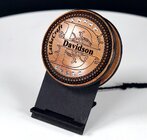Can anyone tell me anything about Sycamore? There is a 20" dia. tree that is comoing down that I can have. Thanks
-
December 2025 Turning Challenge: Single Tree! (click here for details) -
Congratulations to Bob Henrickson, People's Choice in the November 2025 Turning Challenge (click here for details) -
Congratulations to Steven Gordon for "Dropped Ice Cream Cone" being selected as Turning of the Week for December 8, 2025 (click here for details) -
Welcome new registering member. Your username must be your real First and Last name (for example: John Doe). "Screen names" and "handles" are not allowed and your registration will be deleted if you don't use your real name. Also, do not use all caps nor all lower case.
You are using an out of date browser. It may not display this or other websites correctly.
You should upgrade or use an alternative browser.
You should upgrade or use an alternative browser.
Turning sycamore
- Thread starter Paul M. Kaplowitz
- Start date
Paul,
I really like sycamore wood. If you turn it wet and thin it moves a bunch. Roughing it out - it moves a bunch also. I would turn it a bit thicker than normally. When it dries it does not seem to want to crack as much a a lot of other woods. Wet it has a lot of water in it. Bleaches nicely. Has nice rays. Generally good stuff to turn as far as I am concerned.
Hugh
I really like sycamore wood. If you turn it wet and thin it moves a bunch. Roughing it out - it moves a bunch also. I would turn it a bit thicker than normally. When it dries it does not seem to want to crack as much a a lot of other woods. Wet it has a lot of water in it. Bleaches nicely. Has nice rays. Generally good stuff to turn as far as I am concerned.
Hugh
I mostly agree with Hugh, it does move a lot but I find it cracks pretty readily so handle it appropriately. I get plenty that's interesting but quite a bit that's very plain. The first coat of finish usually pulls a lot of grain so I recommend a coat of sanding sealer or two. Otherwise it finishes nicely.
I've turned quite a bit of it dry so I haven't had any problems with cracking. It still turns very nicely and has a unique 'fish scale' pattern on one orientation of the pores. It is fairly light weight, but still strong. Has a lighter color, more tan and brown rather than yellow. I sand my pieces to at least 1,000 grit, use satin tung oil as a finish and haven't needed any sealers or fillers.
Steve Worcester
Admin Emeritus
It still turns very nicely and has a unique 'fish scale' pattern on one orientation of the pores....
Quartersawn, that's what I couldn't think of when this was posted, but a large tree, cut straight down the log on about 2" on either side of a straight heart will yield beautiful quartersawn figures on the rim of a bowl used with this side as the top.
Also, large sycamores often have nice curly figure at the base. I would have them cut as close to the ground as possible up to the first crotch. We had a rash of dead trees with a fungus jumping from tree to tree in the neighborhoods in north Texas a few years back that got a lot of Sycamore into the hands of turners
Sycamore
You don't have the tools to turn that you really should send it to me.
You don't have the tools to turn that you really should send it to me.
I had rough turned a bowl from very green, very wet sycamore. I noticed after a few days that it had started to crack from the rim. So, I threw it back on the lathe and finished turning it, leaving the walls relatively thin, but did not sand it. I weighed it, then let it air dry until the weight stabilized. Then I power sanded it to 320 and finished it with walnut oil. When we put it into use as a salad bowl, I noticed that after washing and drying it, the bowl felt fuzzy all over, maybe like flannel. I thought that was odd, so I lightly re-sanded it with 400. Nice and smooth. However, after using it again and washing and drying it, the fuzziness returned. Now, the interior which sees a lot more use is becoming smooth, the outside not so much. What do you think causes the fuzziness? Is it simply raised grain? Is this typical of sycamore that is wet-turned to completion, or of sycamore in general? And how do I avoid it in the future? Your input is appreciated.
Try a coat of sanding sealer on the fuzzies, let it dry well before sanding. That should stiffen the fibers to allow the sandpaper to shear off the fuzz better.
Love Sycamore. It spalts beautifully, and I actively promote this in my wood pile. Be careful though as it seems like it goes from spalt to punky overnight.
- Joined
- Feb 6, 2010
- Messages
- 3,454
- Likes
- 2,522
- Location
- Brandon, MS
- Website
- threeringswoodshop.square.site
I did a dough bowl in it about 12 years ago. It might have been a little fuzzy at first but considering it’s use I do no wash it every time it is used. As a matter of fact I rarely use it.
- Joined
- Jul 18, 2018
- Messages
- 1,328
- Likes
- 2,862
- Location
- Baltimore, MD
- Website
- loujacobswoodturning.com
I’ve had experience with sycamore showing ring shake (separation along growth rings). But if you get solid pieces, as others have said, good to work with. Also good for embellishing as it can be fairly subtle grained and light colored.
I did turn some Sycamore, large and smaller, turns nicely and has good color, a bit softer than hard Maple.
Never had any difficulties with splitting or warping, though I do give it time to dry slowly as that is my way of controlling any wood (SLOW).
Couple of pictures, 2 of a large Sycamore that I turned and one that shows the color and finish, it had some steel in it also some spalting as well. the last picture shows some of the grain you can get depending the way it is sawn.
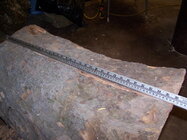
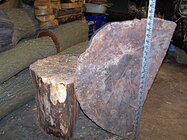
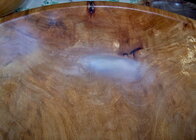
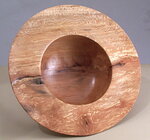
Never had any difficulties with splitting or warping, though I do give it time to dry slowly as that is my way of controlling any wood (SLOW).
Couple of pictures, 2 of a large Sycamore that I turned and one that shows the color and finish, it had some steel in it also some spalting as well. the last picture shows some of the grain you can get depending the way it is sawn.




Thanks, Gary.Try a coat of sanding sealer on the fuzzies, let it dry well before sanding. That should stiffen the fibers to allow the sandpaper to shear off the fuzz better.

